Stagonospoa Curtsii (red blotch) help
I am a new to Amaryllis. I have my first two Amaryllis bulbs recently. One brought from Thanksgiving last year at a Whole Food store, another one just 11 days ago from Longfield on-line.
The first one has big beautiful blooms, but the red blotch spreading fast at the blub, the 2nd one started within a few days after delivery, but a lot less but developing quickly.
The first one still has flowers and towards the end of the cycle. The leaves are perfect. I am hoping; I still can save the bulb after cutting the flower off and cut out all the red and soak it with copper fungicide. Part to learn how much or how far I can rescue the plant.
The 2nd one, I am just to wash with and take out the outer skin and hope for the best.
Do "Stagonospoa Curtsii (red blotch)" airborne and one contaminated the other? It is rather discouraging to see my new hobby start out poorly. Am I just bad luck or there are many ways to safe guild the disease? Does everyone has this fungus in your bulbs before. How common is it?
I like to hear all your comments and opinion to side step my encounter.
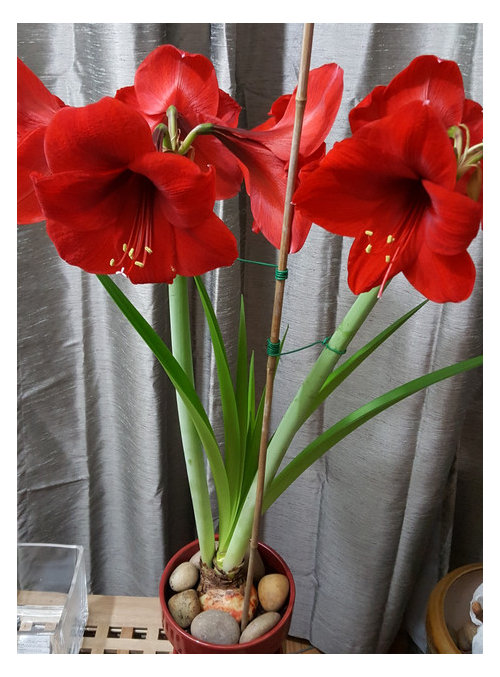

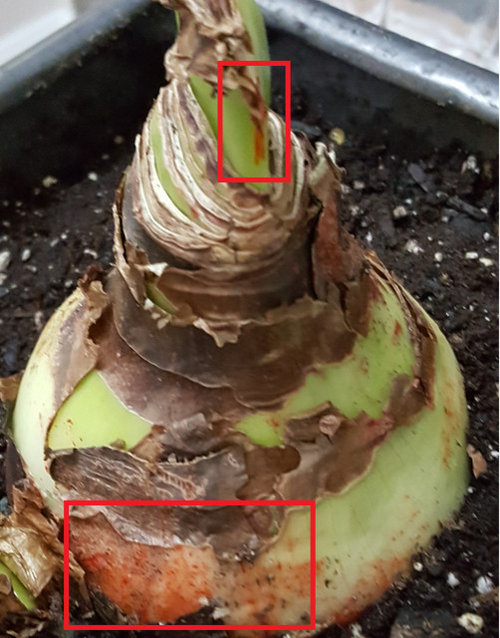
Comments (61)
aacor11
7 years agoThe bulb should not move at all, movement will set back the growth of the roots. try not to touch it or put some sticks to keep it stable
Padraic Ley thanked aacor11Padraic Ley
Original Author7 years agoOn the older one, the one that the flowers are in bloom. I took the soil just above the root out. Expose the blub; the idea is to minimize the contact to the infested soil and decrease the moisture. Planning to use the fungicide to slow down the Red advance until the flower ended in a few days. The root looks ok from the top. I assume it is good since the leaves and flowers are perfect.
Although, it has fallen over once from being new in this. Additionally, I bury the bulb almost to the neck when I planted it last November. Then I lower the soil line during the first flower. With over watering and water overhead at the bulb doesn't help. Then I put rocks around and top of the bulb to stablished it. That may decrease air circulation, and the fungus has the upper hand. I guess all these.
From the web, the flower last for a month, my first, this one, last about ten days per flower stalk and this one has two, the first flower ended a couple of days ago and the second one looks like ending in a few days. Total about 20 days. Is that normal?
I will be monitoring how it goes. I peel off the dry crusted paper thin red layer off, and the bulb visually looks better. Below is not too soft, still feel sufficient hard but irregular. It seems the fungus is consuming the bulb layer to live, the infected layer dried up and thin. Like those SciFi movies that the alien suck out the juice of a human. LOL.
There is still a lot of Red in various part of the bulb. More than the other one. Hope it doesn't spread too fast without moisture.
An education for sure and my wife think this too much work, to learn what works and don't on Amaryllis.
Please give me any guide on my treatment to these plants. Link on more picture these plants.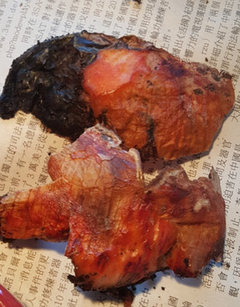


and ideas I can do better.
aacor11
7 years agolast modified: 7 years agoIf the flowers don't last long maybe your house is too warm? Are they near a radiator or another source of direct heat? maybe full sun?
Here in the South of France we had 20C for a few days and in full sun it was much much warmer.
When you say that the flowers wilt, have they been pollinated - do you see the seedpod forming? That can be another cause for wilting flowers?
I suppose stress could also be one.
aacor11
7 years agoThe outer layers of the bulb do wilt and die off in time. Wait until the flowers end without watering - stick your finger in the soil and if it is dry to 5cm under the surface you can water, otherwise not.
When the flowers are over try to have a look at the roots gently and perhaps change the soil to something that dries out fast. Can't advise in that respect as I am still experimenting. Don't feed them when they are sick, except a weak folliar feed with fish emulsion or algae but very diluted. Patience and a good environment is the key to success. If you can, avoid fear or panic. Observe the reaction in time.
When things go well you could water with some plant teas like chamomile, stinging nettles, horsetail or others. The bulbs are heavy feeders and mine adore organic feed. So either buy an organic tomato fertilizer or make your own concoctions making sure you provide trace minerals, some N, less P as it tends to stay in the soils and accumulate, and some high K feed. Very dilute so you don't burn the roots, etc.
aacor11
7 years agolast modified: 7 years agoWhen I clean I do not do a "surgical" clean, though I suppose I should. My logic is that in nature the bulbs do get some outer layers drying out. Do disinfect though. If you insist you can dry it with rooting hormone. Just air drying should be just fine.
My soil is half sand and pebbles half shop mixture for plants. It is nto ideal and I can't recommend it. I only water in the pebbles and only when I see no sign of water/moisture on the glass - in this weather about once a month or less. In the summer it becomes once a week.
I feel responsible in this position as "adviser". If you have a friend or neighbor who is a professional grower or if you have a grower of some sort in your vicinity, try to visit him and ask for some professional products. He might give you just enough to treat these bulbs as I think that you worry too much.
Padraic Ley
Original Author7 years agoaacro11, one set of flower witted, the other one is not. yes, I see potential seed pod behind the flower, if I am right.
So the flower should can last longer, good to know. There may be too much sun (heat), it was at the north window, then I move to a south window. The temperature in the house is 20C (68F). Maybe cooler by the windows.
I don't know there is a practice to pollinate, that keep the flower last longer?
More to learn.

Padraic Ley
Original Author7 years agoDo I need to cut out the root rot area? And the dry/dead root from the mother bulb.
aacor11
7 years agoIf there is a seedpod forming, then that part that you circled should swell and grow. When you pollinate, the flowers last less. 20C is quite warm and possibly dry, try to bring the general temperature to 18C?
In a South window and full sun it is certainly much more than 20C, this would stress the plant if it is sick.
Padraic Ley
Original Author7 years agoI will try your pebbles/sand/soil setup. I definitely have too much water. That is good news since fungus like moisture. Sound like your pebbles/sand/soil are in layers vs a mix, it that right?
aacor11
7 years agolast modified: 7 years agoThe dry roots would be either soft to touch or empty and would come off in your hand. The basal plate is necessary for new roots so I would not cut it just dry it well before replanting. do disinfect it with fungicide
If humidity is low as you say, you can put a plastic bag on top of the plant after repotting but do not close the bag so there is air circulation. Or maybe put a tray with water and pebbles under the pot without reaching the base of the pot to provide humidity around the leaves. All this is not necessary if you manage to drop the temperature to 18C because then the air retains more moisture.
aacor11
7 years agolast modified: 7 years agoPebbles at the bottom for a water reserve (I am lazy at watering) and then the rest is mixed, the bulb is placed at the top with an inch of soil around its base. I water only in the pebbles at the bottom and having a transparent pot I can see the roots growing toward that water reserve. Of course, if the top soil is bone dry (you can see also because you have a transparent pot) I water a little at the top for the little puppies the mother bulb made. I can also see how much I water at the top because I have a transparent pot.
must have said transparent pot quite a lot, sorry
It must not be clear that the water never touches the soil, I keep it only in the pebbles. I sometimes water the top soil if it is bone dry; the water at the top never reaches more than 1 inch into the soil.
for me it works because I can see what is happening through the glass
aacor11
7 years agolast modified: 7 years agoSouth woudl be great if the plant was well established. And watering would be quite often I imagine with all the sun and the heated house.
aacor11
7 years agolast modified: 7 years agoIf the roots are not rotten or disturbed, you can take out the second bulb also and put it in a non glazed pot; those pots breathe and loose water fast.
forgot to say, my name is Alex
"fast" is relative, maybe it shows that I am slow at watering
I'll post some pictures Monday or Tuesday with the bulbs planted in sphagnum, it should be a pretty sight.
Padraic Ley
Original Author7 years agoSo your setup similar like this in layers. This example is may not good since the open is small to put water in. We want a big opening to direct water to the bottom without wetting the Amaryllis plant.
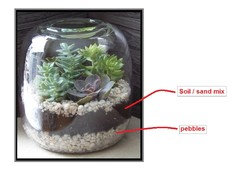
aacor11
7 years agolook read the answer at the end of this thread; it is better than mine
https://www.houzz.com/discussions/just-got-my-shipment-dsvw-vd~1759386
aacor11
7 years agolast modified: 7 years agomy pebbles are big as 1 cm at least
on top of that the soil, sand and pebbles are mixed not layered
I am not a "surgical" cleaner, it could be bad. Personally, I have a "soft" approach.
Padraic Ley
Original Author7 years agoTechnically, the bulb doesn't need to touch the soil, right? Just the root to get nutrients to the plant.
The soil is better than water alone because the soil has more nutrients. People use soil cover half of the bulb to stabilize the top-heavy flower, is my guess.aacor11
7 years agolast modified: 7 years agowell, not all hippies act the same. Some have parents that come from marshland. Some have to have air to their roots...
The base of the bulb generally needs to touch the soil, I keep my bulbs 2 inches deep . It is bad I know. It keeps moisture near the bulb. In my case it is good as I tend to let the soil dry out completely. Thus in my case it prevents dessiccation.
I had fishes and thus the big water containers were in my home doing nothing. Easy to use. Try a big plastic water container as they are very cheap and after you learn what your bulbs like, transfer to a pretty more expensive pot.
Padraic Ley
Original Author7 years agoThanks for the link, I didn't know sphagnum moss has antibacterial properties. Is that red part of the baby also rot. I assume it is red because the attachment to the mother got broke off?

Padraic Ley
Original Author7 years agoFrom the UK site.... Any infection on the leaves and stem must be cut out, and any infected bulb scales must be peeled back until the bulb is ‘clean.' Then the plant must be soaked in fungicide and, when it is dry, dusted with sulfur powder and then potted up in the sharp sand so as to minimize conditions for re-infection and to encourage strong root growth. The plant is then kept in quarantine, with further applications of fungicide after about two weeks and during the next growth cycle. If the plant remains in the sharp sand for an extended period, it is sensible to give it some liquid feed. I then cross my fingers and wait as, while many of the plants treated in this way appear to recover, success is by no means guaranteed. The surgery that I have described can be quite traumatic, not least for the surgeon (!), and is best left to an expert, particularly one who has access to an effective fungicide. If damage to the infected bulb is extensive, twin scaling is the best option and, in expert hands, good results have been achieved, saving rare plants that might not otherwise have survived.
aacor11
7 years agoThank you! look from Jodik an answer to your question
"I would remove it from its pot, clean all the old soil from its root system, clean up the bulb by removing all the dead leaves, dried bulb layers, and any dead roots... then, I would dust the bulb with a light coat of Captan anti-fungal powder as a preventative against rot and fungi... then, I would re-pot the bulb into a fresh medium that will allow the roots to breathe, leaving about 1/2 to 2/3 of the actual bulb above soil level.
The medium type that many of us use is made up of small pine bark pieces, perlite, and either granite chips or turface... or something very close to that mixture. We're looking for a medium that is more inorganic, does not decompose fast, allows for good aeration, drains well and quickly, and allows us to control the moisture and fertilizer levels. We've begun to mix our own mediums because the retail market doesn't carry anything pre-made that gives us what we want."
Padraic Ley thanked aacor11jstropic (10a)
7 years agoThis time of the year, where you have a cold winter, for most hybrids, your biggest problem is going to be wet conditions. Because we want to "fix" the problem 'immediately' we often make it worse. If a plant is stressed and has little roots it can not use the water so you need to allow it to grow more roots, especially before fertilizing.
Remember what Jodik wrote then was a simple starting mix. Most of us here have learned from watching our bulbs and growing species that we often have to change things around a bit. Some bulbs like organic matter while others thrive in more rocky conditions. Some grow more like orchids. Some bulbs like little pots and pot-bound conditions while others sulk unless in large pots. One thing they all seem to have in common is that wet and cold = rot.
Padraic Ley thanked jstropic (10a)Padraic Ley
Original Author7 years agoaacor11 (Alex) and jstropic, thanks for the generous help. I felt better in understanding the nature of Amarlyllis/bulb plant and their variance. I learn a lot from your comments and focus my research on the web.
You may already know, this link (PBS) seems to have a lot of good fundamental information for the Amaryllis, granted we have the hybrid version, I believed.
aacor11
7 years agoI also didn't have captan so I powdered the cleaned parts of the remaining bulb and the wounds with dry camomille (I drink a lot of that tea). It seems ok and it stopped the rot. then I placed some more dry flowers of camomille on top of the sphagnum from the bag , the bulb on top; all in front of a window with mild bottom heat.
see, my approach is a bit mild...
Good luck with yours! try not to move them to avoid stress to the plant Keep us posted with pictures
aacor11
7 years agolast modified: 7 years agoI saw some other members were interested in seeds/bulbs. Probably bulbs would be better, I'm not sure how they would fare in the post. When I get the seeds I'll post here Living in France it may not be possible to post bulbs/seeds to USA
Padraic Ley
Original Author7 years agoAlex, so you are French? I have never talked to a French national..It has been an excellent experience. I probably like to play with seed further down the in the hobby. It is a bit early now. I am expanding my collection once these two under control.
Padraic Ley
Original Author7 years agoI just order some Captan power, will use it to dust the bulb root before planting. It is still in air dry process.

aacor11
7 years agoDear friends I am not French, I just live in France. To be honest if I was to send something it would be probably small bulbs and not seeds because they are so long to care for before flowering and because they may not travel well long distances.
Padraic Ley thanked aacor11Padraic Ley
Original Author7 years agoThanks, Alex, sorry mistaken you are French. Do people in the forum trade bulb often?
aacor11
7 years agoProbably not. I don't know because I am so far away from US.
I just saw you were so worried and upset and I wanted to send you an easy bulb to care for - striatum is a reliable easy hippy.
Padraic Ley
Original Author7 years agoI got a replacement from the Longfield Garden for my 2nd Blub. But the replacement look worse than the original one, on red blotch after clean up the original one. I email supplier, and she said the plant would grow just fine.
So, it sounds like selling disease bulb is a regular practice in this industry. I am disappointed; they sell bulb knowing it has fungus.
Is there an online store sell healthy bulb?
aacor11
7 years agoWell, it doesn't look so bad to me - I can't see any rotten parts. It is true that the basal plate is not visible. If you could check for signs of rot there it should be better. By now you probably planted it away.
Patience and relax!
If you are convinced they are rotten Jappm recommended planting in sand for a while to help the bulb heal and give better water control. He didn't mention anything else - how he watered or his type of pots. You could ask him though.
Padraic Ley thanked aacor11Padraic Ley
Original Author7 years agoThe new bulb #4 came in with some Red, so I used hot water 45C bath treatment for an hour+. I think it should be three hours. I also use Captan powder to dust the bottom of the plate before I settle them on soil mixture.
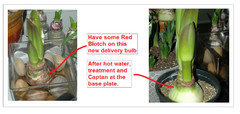
Padraic Ley
Original Author7 years agoTo help reduce fungus issue, I decided my soil mixture for Amaryllis flowering period with Vermiculite above the root plate and Perlite below. A thin layer of Captan powder between the two layers to discourage fungus growth. Let's see how this work out in the next few months.

berkeleysgr8
7 years agolast modified: 7 years agoBottom watering of the bulbs should help prevent splashing and spreading the fungus to other bulbs. I have a number of Chico and Emerald offsets that have been treated with bleach or hydrogen peroxide and heat (110 degrees for an hour- I used a sous vide cooker to keep the temperature steady). I don't know if these "treatments" will work... but it's worth trying to save the bulbs, if they can be healthy!
Padraic Ley
Original Author6 years agoIt is October now, all 7 of my Amaryllis bulbs did well. The last bloomed at May. During the summer, I water more as I supposed to. The red blotch doesn't show much now at October. I appreciated the advice here on the red blotch. It helps a lot in my first-year experience on what I should expect.
The outer layer turns brown and the leaves were tall and long. I should have put them outside for more sun but I didn't. Now in fall and I am moving soon. I put the outside and hope to catch the life cycle.
In my area, the weather still warm. So I left them alone until the temperature drop and go thru the dormancy cycle. So these bulbs are going to bloom next year if they can or not.
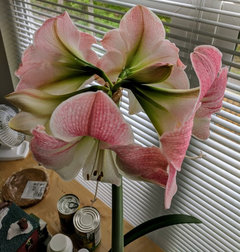
oleg9grower
6 years agoWill your bulbs to bloom? It depends how many large leaves have grown over the season, how much light they have received. In general, the bulb lays a flower stem through every 4 leaves. But if there are not enough reserves, the incomplete flower bud does not develop. Hippeastrum plant should receive at least 7 months of growth in the sun. I do not know where you live, enough light for the window. The bulb need fertilizing, at least sometimes. If the bulb is large, then flowering is due to good growth in the past and even the year before last.
everado
6 years agoThey like a lot of sun. I used to keep mine in full sun all day, but inside a screen enclosure so that the intensity of the light was reduced a bit since I live so far south. There are risks to putting them outside (NBF and virus), so you have to weigh whether it is worth the risk in your area. They also love fertilizer and many people on here (myself included) water them with diluted fertilizer instead of just water.
Padraic Ley thanked everadoPadraic Ley
Original Author6 years agoThanks for the tips. I am in North Virginia. They were placed at south windows, but window screen reduced the light. They had more than 4 leaves and longer than a foot.
Is NBF everywhere in the US? Would a dom screen can prevent the bulb getting the infected?
Luca B.
6 years agolast modified: 6 years agoStagonospora curtisii was renamed Peyronellaea curtisii
You can prevent Peyronellaea curtisii with Organic Pesticides (natural antagonist) Trichoderma harzianum ICC 012 and Bacillus subtilis are valid antagonist.
But they are not valid when the infection are live...
Padraic Ley
Original Author6 years agoDo you have a link to these "natural antagonist"? The red blotch seems always with Amaryllis.
After one year, research, shopping Amaryllis online and local. I can see red blotch in all products sold. Most are minor infected, but it is obvious to the eye from my experience.
I derived a process below, so it is under control and none observed so far on my 1st bulb started 5 weeks ago.
It is in full bloom now, started at the south warm window and moved to the cooler north side of the house to slow the flowering process. I am starting a 2nd one today using the same process. The attached photo was the new bulb I bought this year from local. The seven I bought last year are still in the dominant state.
1. Keep the bulb dry at all time,
2. Bottom-up watering,
3. On new bulb, I start it soaking in bleach mix with hot water at 120F water bath for a few hours,
3. Then dry it out with a small fan on it for a couple days while the bulb starting on the water with base plate slightly above the water line.
4. Transplant bulb to a pot after a few days with loose soil (cactus type mix) with bottom of the pot touching a pan of water,
5. The bulb will look bone dry with green flower spike coming up,
6. After the flower above to start out, put the pot in a tall glass cylinder to help support the height of the plant with foam or cardboard cut out at the top of the glass cylinder.
I bought seven this year below (6), first one was from Home Depot at $7 each but smaller than these at the high-end local nursery at $17 each. These are big over a pound in weight, one tip the scale at 23 oz.
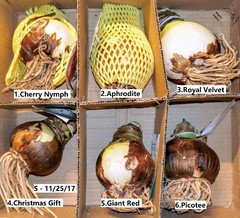
So I have 14 total in my collection and curious how last year bulb turns out.
Luca B.
6 years agoHi
Here you can found a long post about them http://www.srgc.net/forum/index.php?topic=5172.0with several products
Peyronellaea curtisii (Stagonospora curtisii) is fatal (lethal) for some bulbs like snowdrops.Padraic Ley
Original Author3 years agoThis thread becomes my Amaryllis journaling experience from my bulbs.
The 12 out of 14 originals did well a year ago after I moved crossed the country for retirement. I left it with my sister in California. The dominant schedule for the bulb was completely off. So they bloom in the summer instead of in the winter in 2019.
My retirement place in in the hot Southwest up to 115 F in the summer. After I brought them here for this summer. I was trying to let the leaf to re-rejuvenate the bulb by leaving it outside. That turns out to be too hot for them. So I am not sure if they still have anything left.
I was lucky and brought two new big ones from Home Depot at $10. Very good price. They are going thru bleach and hot water treatment at this moment.berkeleysgr8
3 years agoI find that amaryllis do fine in weather over 100 degrees, as long as they're getting enough water. However, we very rarely have 115 degree weather where I live. That is really hot by ANYONE'S standards!
I discovered several years ago that if you leave soda cans in your trunk during 113 degree weather, the can explode, like someone dropped explosives in them! That same summer, I had a friend in England who was complaining that he and his family would die of heat stroke due to the "hot" 85 degree weather they were experiencing. He didn't believe me when I told him what our weather had been!



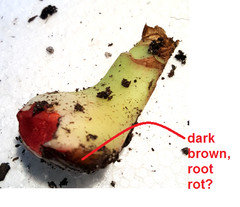
aacor11